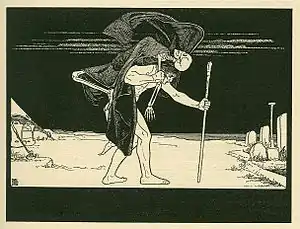
In Jewish mythology, a dybbuk (/ˈdɪbək/; Yiddish: דיבוק, from the Hebrew verb דָּבַק dāḇaq meaning 'adhere' or 'cling') is a malicious possessing spirit believed to be the dislocated soul of a dead person.[1] It supposedly leaves the host body once it has accomplished its goal, sometimes after being exorcised.[2][3][4]
Etymology
Dybbuk comes from the Hebrew word דִּיבּוּק dibūq, meaning 'a case of attachment', which is a nominal form derived from the verb דָּבַק dāḇaq 'to adhere' or 'cling'.[5]
History
The term first appears in a number of 16th-century writings,[2][6] though it was ignored by mainstream scholarship until S. Ansky's 1920 play The Dybbuk popularised the concept in literary circles.[6] Earlier accounts of possession (such as that given by Josephus) were of demonic possession rather than that of ghosts.[7] These accounts advocated orthodoxy among the populace[2] as a preventative measure. Michał Waszyński's 1937 film The Dybbuk, based on the Yiddish play by S. Ansky, is considered one of the classics of Yiddish filmmaking.[8]
Rabbi Yoel Teitelbaum, the Satmar rebbe (1887–1979), is reported to have supposedly advised an individual said to be possessed to consult a psychiatrist.[7]
Traditionally, dybbuks tended to be male spirits who possessed women on the eve of their weddings, typically in a sexual fashion by entering the women through their vaginas, which is seen in Ansky's play.[9]
In psychological literature, the dybbuk has been described as a hysterical syndrome.[10]
In popular culture
Few topics in Jewish theater history have inspired as many stage treatments as the dybbuk. A review of the innovative approaches to the subject was presented by EgoPo Classic Theater in English translation from the Yiddish, as penned by Joachim Neugroschel and adapted by Tony Kushner, the production directed by Lane Savadove.[11] Containing detailed background information on the history of the dybbuk, "'Don't ask me what happened. It’s best not to know!': A DYBBUK, or Between two worlds"[12] the article was first published by All About Jewish Theatre[13] the world's largest English-language Jewish theater website, before its demise in 2014, but recently rescued by Drama Around the Globe[14] and republished by Phindie.[15]
The Dyke and the Dybbuk is a 1993 novel by Ellen Galford. The novel is a satirical story based in which an ancient dybbuk returns to haunt a modern-day London lesbian.
Max also has a show called Possessions which is an account of Dybbuk.
In the fantasy role-playing game Dungeons & Dragons, the Dybbuk was introduced as a disembodied demonic spirit that could possess and control dead bodies. They parasitically inhabited mortal corpses in order to partake in their vices and would murder others to steal their forms. First introduced in the third edition, they were remade for the fifth edition D&D, and the most current version, as of April 2023, can be found in Mordenkainen's Monsters of the Multiverse (p.113).
In the 2009 horror film The Unborn, the main character is haunted by a dybbuk which appears as, among other forms, a dog with an upside down head.
The Possession is a 2012 American supernatural horror film directed by Ole Bornedal and produced by Sam Raimi, Robert Tapert, and J. R. Young, and written by Juliet Snowden and Stiles White. In this movie a young girl gets possessed after buying a dybbuk box at a garage sale.
The 2017 Indian Malayalam language horror film Ezra is about main characters getting possessed by evil spirits after they come in contact with a dybbuk box. Ezra was remade in Hindi in 2021 as Dybbuk.
In 2019, the short film "Dibbuk"[16] directed by Dayan D. Oualid deals with an exorcism within the Parisian Jewish community.
See also
References
- ↑ Trachtenberg, Joshua (2004) [Originally published 1939]. "Glossary of Hebrew Terms". Jewish Magic and Superstition. Philadelphia: University of Pennsylvania Press. p. 333. ISBN 978-0812218626. Retrieved 10 January 2023.
Dibbuk – spirit of deceased person which has entered body of living person.
- 1 2 3 Avner Falk (1996). A Psychoanalytic History of the Jews. Fairleigh Dickinson Univ Press. p. 538. ISBN 978-0838636602.
- ↑ "Dybbuk", Encyclopædia Britannica, retrieved 10 June 2009
- ↑ Gershom Scholem. "Dibbuk". Encyclopaedia Judaica.
- ↑ See A. Sáenz-Badillos & J. Elwolde, A History of the Hebrew Language, 1996, p. 187 on the qiṭṭūl pattern.
- 1 2 Spirit Possession in Judaism: Cases and Contexts from the Middle Ages to the Present, by Matt Goldish, p. 41, Wayne State University Press, 2003
- 1 2 Tree of Souls:The Mythology of Judaism, by Howard Schwartz, pp. 229–230, Oxford University Press, 2004
- ↑ "The Dybbuk". The National Center for Jewish Film. Retrieved 29 October 2014.
- ↑ Levin, Sala. "Jewish Word: Dybbuk". Moment Magazine.
- ↑ Billu, Y; Beit-Hallahmi, B (1989). "Dybbuk-Possession as a hysterical symptom: Psychodynamic and socio-cultural factors". Israel Journal of Psychiatry and Related Science. 26 (3): 138–149. PMID 2606645.
- ↑ Lane Savadove
- ↑ "'Don't ask me what happened. It’s best not to know!': A DYBBUK, or Between two worlds"
- ↑ All About Jewish Theatre
- ↑ Drama Around the Globe
- ↑ Phindie
- ↑ https://www.imdb.com/title/tt10772310/
Further reading
- Chajes, J. H. (2011). Between Worlds: Dybbuks, Exorcists, and Early Modern Judaism. University of Pennsylvania Press. ISBN 978-0812221701.
- Elior, Rachel (2008). Dybbuks and Jewish Women in Social History, Mysticism and Folklore. Urim Publications. ISBN 978-9655240078.
- Peñalosa, Fernando (2012). The Dybbuk: Text, Subtext, and Context. CreateSpace Publishing. ISBN 978-1478357803.
- Peñalosa, Fernando (2012). Parodies of An-sky's "The Dybbuk". CreateSpace Independent Publishing Platform. ISBN 978-1477647721.
- Cutler, Yosl (March 2017). "The Dybbuk in the Form of a Crisis". In Geveb. Archived from the original on 6 March 2023.
External links
- "The Dybbuk" by Ansky Jewish Heritage Online Magazine
- "Dybbuk – Spiritual Possession and Jewish Folklore" by Jeff Belanger, Ghostvillage.com
- "Dybbuk", Encyclopædia Britannica
- Dibbuk short film teaser
- ডিব্বুক (Dybbuk) – Bengali horror fiction based on Dybbuk myth by Tamoghna Naskar. Publisher – Aranyamon Prokashoni https://www.aranyamon.com/